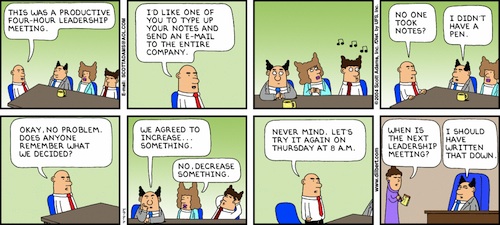Take a deep breath and say it with me: not everything needs to be a meeting. Pause, and now say it loud and say it proud: some things can be an e-mail, a quick talk in the hallway, or a trip to the gym. Pause again, take a swig of that coconut water, and repeat: the meeting is not the be-all and the end-all.
I heard an interesting story on a job interview I did about a week ago. One of the guys I was interviewing with used to work for a pretty big company (insurance sector), and one thing they would do is go around to conference rooms and hang up signs of how much the meeting inside was costing — let’s say it’s a 1-hour meeting with 21 people. You basically take the hourly salaries of everyone in there and add ’em up. For certain meetings, you’re strolling past and are like, “Jeebus, that’s a 12K meeting?!?!?” Now of course, it doesn’t actually work like that — it’s not that hard and fast, in other words — but it’s an interesting device to get people to contextually re-think the experience.
Hopefully this is too: via Harvard Business Review, here’s a weekly senior leadership meeting that ultimately ended up costing the company involved about 300K work hours (across all levels) in a year. 300K hours is the equivalent of the entire year for 34 different people. How did it work? Well, you can click the link to look at all the math, but essentially, senior staff needs to meet with unit chiefs (to get updates), unit chiefs need to meet with their direct reports, their direct reports need to have all-hands meetings, etc. In the end, it totals about 300K — again, the entire annual life of 34 humans — hours.
Because everything that makes a difference in business discussions is ultimately revenue-facing and has ROI, here’s the essential takeaway from the Harvard study:
How companies can use time effectively is just one piece of a larger and ultimately more important puzzle: how to increase the productivity of their people. Boosting human capital productivity (HCP), we have found, is a powerful and often-neglected pathway to better performance.
Our research quantifies what’s at stake. Using a decade’s worth of data for the S&P 500, we looked at revenue per employee, a crude but useful measure of HCP. Then we compared those figures with each company’s financial performance. Since revenue per employee varies widely among industries, we confined our comparisons to companies in the same business.
The results jumped out at us. The best companies — those in the top quartile of revenue per employee — did 30% better than their peers in return on invested capital, 40% better in operating margin, and 80% better in revenue growth. Those differences contributed to a whopping 180% differential in total shareholder return over the 10-year period.
This all rolls up with one of the central challenges of modern business. Because everything is so quarter-focused (i.e. every 90 days, and the returns you’re offering within that span), priorities are very tight. People thus tend to focus on things they can control, as opposed to things that might make a difference (do make a difference) but are more intangible. Examples: social media, hiring, and how to run meetings. One of my friends used to tell me that the most frustrating part of his day was that he felt like he didn’t actually do any work until 4pm — when the meetings were finally over. At that point, he felt drained (we all do) and put in maybe 2-3 hours on follow-up from the meetings before the same process began anew. Repeat five times and that’s a work week. That’s actually not how the human brain processes action at all.
Basically, it breaks down like this: spending 300K people hours on 42 or so weekly senior staff meetings is a total waste of time, and most people involved in those 300K hours would probably actively admit that. The problem is — it seems like the right thing to do. Senior staff has to talk, and has to know what’s going on around the business. Right? Right? So it’s a necessary evil, no? I mean, right? Well, yes and no. Senior staff does need to communicate — everyone needs to communicate — but there might be ways to cut that 300K figure down (and again, not every company is spending 300K hours on preparing for a once-weekly meeting). You can do simple things: have a shared Google Doc where, every Thursday, team members leave updates on their progress (both pro and con) on different deliverables. If the team lead needs clarification, he talks to the person/people whose stuff needs clarification. Cool. Right there, with one shared doc, you eliminated a bunch of meetings. That funnels time back to people where they can be productive on actual work (or, hell, they can schedule different meetings with other people).
Or, you could hold the same amount of meetings but simply hold them standing up … it traditionally reduces the time involved by 34 percent, but keeps the quality of decisions relatively intact.
The broader point here? Think about stuff like people, how people are spending their time, where people’s talents could best be utilized, etc. Those aren’t necessarily topics that relate directly to the bottom line and shareholder value, but over time they relate immensely to those topics, so some kind of best practices around them do need to be considered.

Reblogged this on Uthmanx.